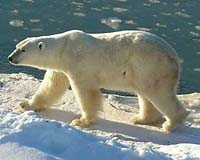| . |  |
. |
Seattle WA (SPX) Dec 21, 2010 Polar bears were added to the threatened species list nearly three years ago as their icy habitat showed steady, precipitous decline because of a warming climate. But it appears the Arctic icons aren't necessarily doomed after all. Scientists from several institutions, including the U.S. Geological Survey and the University of Washington, have found that if humans reduce greenhouse gas emissions significantly in the next decade or two, enough Arctic ice is likely to remain intact during late summer and early autumn for polar bears to survive. "What we projected in 2007 was based solely on the business-as-usual greenhouse gas scenario," said Steven Amstrup, an emeritus researcher with the U.S. Geological Survey and the senior scientist with the Montana-based conservation organization Polar Bears International. "That was a pretty dire outlook, but it didn't consider the possibility of greenhouse gas mitigation." That study projected that only about one-third of the world's 22,000 polar bears might be left by mid-century if the dramatic Arctic ice decline continued, and that eventually they could disappear completely. The work led to the 2008 listing of polar bears as a threatened species. The new research is based in part on modeling proposed by Cecilia Bitz, a UW associate professor of atmospheric sciences. It indicates there is no "tipping point" that would result in unstoppable loss of summer sea ice when greenhouse gas-driven warming rose above a certain threshold. "our research offers a very promising, hopeful message, but it's also an incentive for mitigating greenhouse emissions," Bitz said. Amstrup is the lead author of the Nature paper. Besides Bitz, co-authors are Eric DeWeaver of the National Science Foundation, David Douglas and George Durner of the USGS Alaska Science Center, Bruce Marcot of the U.S. Forest Service in oregon and David Bailey of the National Center for Atmospheric Research in Colorado. Because the scientists were looking specifically to see if there is a tipping point beyond which seasonal Arctic ice could not recover, they used a general circulation model with a sea-ice component particularly sensitive to rising temperatures, with major parts of it designed by Bitz. "We didn't necessarily need to compare with other models since we were using one that is extremely sensitive in the Arctic, which allowed us to make a more conservative statement about the potential to slow the loss of sea ice," she said. Previous work by Bitz and others showed that unchecked temperature increases, along with natural environmental volatility, could result in the loss of vast areas of Arctic ice in less than a decade. It also showed that with continued business-as-usual greenhouse gas emissions the ice did not recover after such rapid ice losses, and it largely disappeared altogether in following decades. However, the new Nature study indicates that if greenhouse gas emissions were reduced substantially in the near future, rapid ice losses would be followed by substantial retention of the remaining ice through this century, as well as partial recovery of the ice that disappeared during the rapid ice loss. Polar bears depend on sea ice for access to ringed and bearded seals, their primary food source. During seasons when they can't reach sea ice, the bears mostly go without food and can lose about 2 pounds a day. The periods when they don't have ice access have increased and are expected to continue increasing with the current level of greenhouse gas emissions. As part of the current study, the potential sea-ice outlook generated by the general circulation model, as well as many features of polar bear life history, were placed into a network model, which can, for example, examine the relationship between polar bears and their environment. Those results indicated that increased retention of sea-ice habitat because of greenhouse gas mitigation would allow polar bears to survive in greater numbers throughout this century, and in more areas of the Arctic, than would happen with no mitigation. Amstrup divided the Arctic into four separate ecoregions according to the nature of ice typically found there, and the 2007 study showed a very high likelihood that polar bears would become extinct in two of those regions given current trends in greenhouse gas emissions. "There's still a fairly high probability in both of those regions that polar bears could disappear," Amstrup said. "But with mitigation and aggressive management of hunting and other direct bear-human interactions, the probability of extinction would now be lower than the probability that polar bear numbers will simply be reduced. "With mitigation, conditions for polar bears might even improve in the other two ecoregions. The benefit of mitigation to polar bears is substantial."
Share This Article With Planet Earth
Related Links University of Washington Climate Science News - Modeling, Mitigation Adaptation
 Polar Bears Still On Thin Ice
Polar Bears Still On Thin IceSeattle WA (SPX) Dec 17, 2010 Polar bears were added to the threatened species list nearly three years ago as their icy habitat showed steady, precipitous decline because of a warming climate. But it appears the Arctic icons aren't necessarily doomed after all. Scientists from several institutions, including the U.S. Geological Survey and the University of Washington, have found that if humans reduce greenhouse gas emi ... read more |
|
| The content herein, unless otherwise known to be public domain, are Copyright 1995-2010 - SpaceDaily. AFP and UPI Wire Stories are copyright Agence France-Presse and United Press International. ESA Portal Reports are copyright European Space Agency. All NASA sourced material is public domain. Additional copyrights may apply in whole or part to other bona fide parties. Advertising does not imply endorsement,agreement or approval of any opinions, statements or information provided by SpaceDaily on any Web page published or hosted by SpaceDaily. Privacy Statement |